Contents
- 1 Fiyin Koko Embodies The Feminine Essence In Her Azure Work
- 1.1 Interior Design: When did your story as an artist begin?
- 1.2 ID: Can you describe your background and your earliest memories of making art?
- 1.3 ID: Why were you most interested in making works in micro-scale, as opposed to large-scale? Was that a problem of portability?
- 1.4 ID: Ever since you began ceramics as a practice, have you exhibited your works?
- 1.5 ID: Do you ever approach your artistry from a spiritual angle of creation? Is there a depth to creating?
- 1.6 ID: More on that, are you open to the viewer’s interpretation of your works or do you feel you have to guide them to understand every piece of your art?
- 1.7 ID: The practice of terra-cotta is an ancient one. Is it safe to say you are reviving the artistry but you are blending it with a modern twist?
- 1.8 ID: You recently unveiled a new collection of work. Tell us about the Ina Collection.
- 1.9 ID: Your work is often in blue; is there a symbolic gesture to using blue fervently?
- 1.10 ID: What are you currently working on, and should we anticipate a solo exhibition this year?
‘Water Me’ exhibition at Yenwa Gallery in Lagos.
Fiyin Koko is a creative with a mission—one that takes into account the vast range of experiences associated with femininity. When we jump on a call one recent afternoon, she’s in the newly-launched AMAH Studio in Lagos, Nigeria, for a week-long residency program where she’s creating her longest work yet. The first installation is titled “Apoti Conversations” and features 12 incredible female creatives who gathered together for an intimate afternoon to have deep conversations about life, womanhood and their creative journeys as female artists last month.
Though the multidisciplinary creative started her journey in 2020, she possesses the artistry of someone who has been refining her craft much longer—reviving the ancient art of terra-cotta with a modern twist. While much of her practice has evolved into ceramic art, Koko began as a digital artist and surfed the NFT wave in Nigeria. But her interest in creating started much earlier, inspired by her mother, who is also an artist and often shared materials with her daughter, fueling Koko’s passion. As Koko says, “Art is in my blood.”
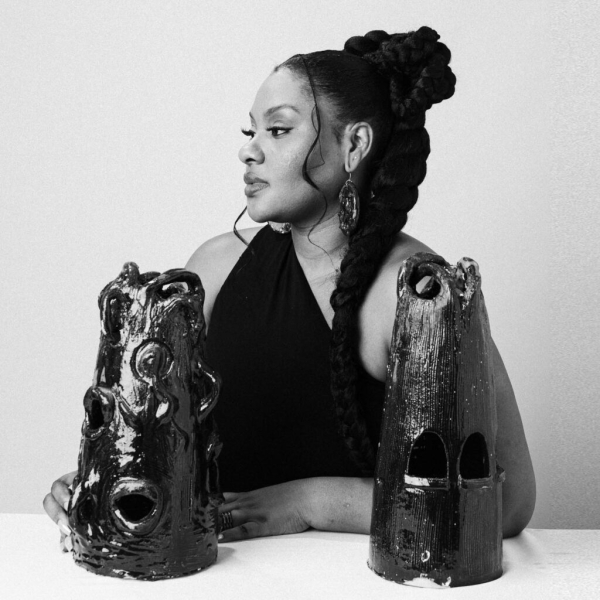
Fiyin Koko.
Much of Koko’s oeuvre explores the feminine and features elements that deal with ceramics. She also loves the color blue and uses it in some of her work to evoke deep meanings that fuel her inspiration, while also fueling mysteries she hope viewers could uncover from her art. Interior Design connected with the artist to speak about reviving terra-cotta practices, making works that embody the feminine essence, and her forthcoming works.
Fiyin Koko Embodies The Feminine Essence In Her Azure Work
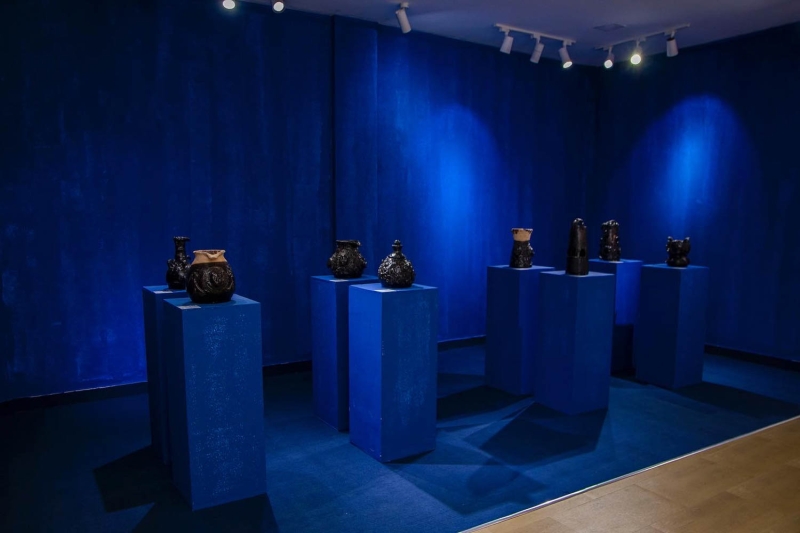
‘Water Me’ exhibition at Yenwa Gallery in Lagos.
Interior Design: When did your story as an artist begin?
Fiyin Koko: My art career started in 2020, before the lockdown. Instead of painting, I taught myself digital design using Photoshop. When I tried ceramic art for the first time, it was because I wanted to touch my art. I was just playing around with air-dry clay and it was exciting—not because it was in my blood, but because I liked it. Then, I started figuring out my style. I wanted to feel what it was like to see art. Everything changed when I started working with clay. I became more present than when I was just doing digital art as clay has several processes—you make it, it air dries, fire it, and then you have the clay piece. It’s a really long process, but that just made me more intentional with my practice.
ID: Can you describe your background and your earliest memories of making art?
FK: My mother is an artist. I grew up being in touch with my creativity, and my mother would give us materials to do whatever we wanted. I’ve always been that gifted kid but I think for me, it’s just something I couldn’t shy away from. While I attended the University of North Carolina, I studied international relations and environmental science, but I was still painting on the side for my friends and for other people. And then I moved back to Lagos. I worked in the natural environment for a while but I was still painting and drawing every day. At some point, I just told myself that I might as well just do it professionally because it was my passion. I quit my job in January 2020, and said: Okay, let me try this thing. Because I worked in marketing, they told me to come back if I wasn’t feeling it. That same year, I had my first exhibition and I was like: Wow, this is what I want to do in my life.
ID: Why were you most interested in making works in micro-scale, as opposed to large-scale? Was that a problem of portability?
FK: I want to [work in large-scale], but I’m just afraid because playing with clay is so brutal and so fragile. I think what I have planned in my head is that I’ll work with a different material later on, maybe with fiberglass or even wood or something that I won’t be so scared to look big, essentially.
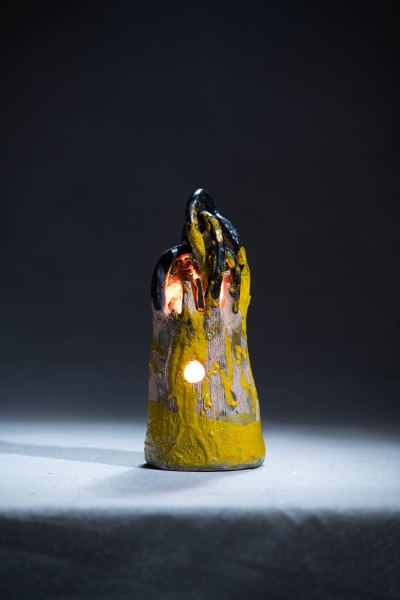
Lighthouse.
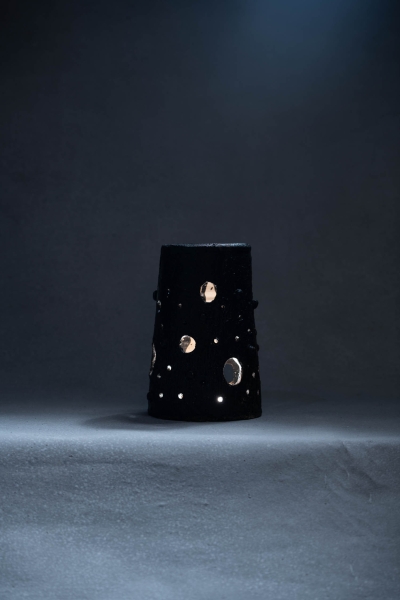
City Lights.
ID: Ever since you began ceramics as a practice, have you exhibited your works?
FK: I’ve done a couple of exhibitions with clay. I want to say it happened very fast. When I started working with clay, many people were just like, ‘Oh, you do clay?’ and then I received more invitations to do exhibitions. I’ve done about seven exhibitions since I started working with clay. I did a solo exhibition in December 2023 at Yenwa Gallery in Lagos that had a whole ceramic aspect as well, which was very good. I think I almost sold out every ceramic piece. The project was called “Water Me” and it was a story about love and support and how my journey started into art. I wanted to create vessels that could house water or light. People know that I work with blue because blue is my foundation.
The whole ceramic section was totally about plants. I wanted the vest that I created to stand out so I used the expand plate, which is like a coffee brown blaze. They just turned the whole thing into jewels which are very shiny. There’s some that could house light, and there’s some that could house clay. I have something that I do with clay where it resembles lighthouses. I want the pieces to be functional because I like how people can just have a sculpture in their house. Sometimes they don’t use it, but often they just interact with it. My thing is for people to connect with the ceramic piece that they’re buying. You can put in your house and then it becomes your lamp because it has holes and different openings. It’s the light that begins on your wall with different shadows. It’s nice and interactive.
ID: Do you ever approach your artistry from a spiritual angle of creation? Is there a depth to creating?
FK: I think for me, the whole process of my art is spiritual. I’m creating from dirt and sand. But in terms of: Do I have the intention to make every piece spiritual? No. When people connect with my pieces, they feel some spiritual things that I don’t even intend to add, actually. Especially with the lines. I had a group exhibition with a couple of artists and people mentioned that this is giving them a very spiritual thing. I think we associate a lot of ceramic art to be a ritualistic vessel. I think the process is spiritual in itself.
ID: More on that, are you open to the viewer’s interpretation of your works or do you feel you have to guide them to understand every piece of your art?
FK: To a large extent, I want viewers to see the work and feel whatever they feel, and get whatever they want. If I’m there and they want to know what this piece is really about, then I will talk about it and speak to them. But, for the most part, I don’t think I’m going to go there. I want them to be able to connect with the piece however they feel like.
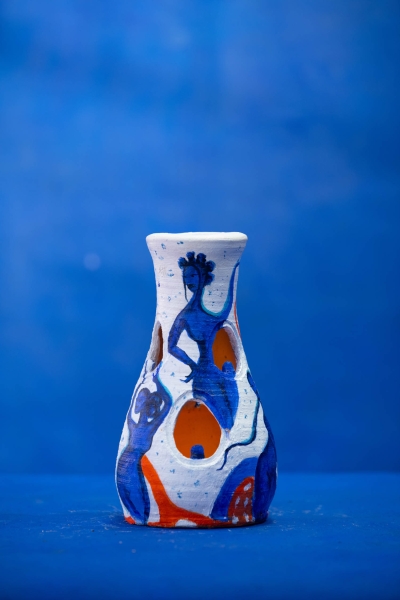
Ile Ina.

Tidal Knots.
ID: The practice of terra-cotta is an ancient one. Is it safe to say you are reviving the artistry but you are blending it with a modern twist?
FK: I think to a large extent we are reviving the artistry because we do terra-cotta in Nigeria very well. However, I’m not even thinking of an Asian influence; I’m thinking of an influence from my village, where I go sometimes to use some of the clay and see how they fire traditionally. Then also, I go to the town of Badagry and look at the clay there. Their clay fires as if it’s like white clay, but it’s very durable. It also has sand with limestone in it, which makes the clay different. I think I’m taking a lot from the things that I’ve seen in the village, things that I’ve seen created in a traditional way. I usually fire them with firewood, since I think it’s interesting to continue using just traditional methods.
ID: You recently unveiled a new collection of work. Tell us about the Ina Collection.
FK: I made my Ina Collection in 2024. It was inspired by lighthouses again, and I used actual bulbs inside the pieces, which I haven’t done before. Usually, I’ll just put candles, but I wanted to put actual lights in there this time. And hopefully in the future— I’m actually talking to some people now—I can do a nice interior design collaboration and have my own natural lights. Anyway, I wanted to create a collection that just told the story of light. Like how you have a light over your head, which helps you realize things and see things clearer. So I started working with mirrors as well and learning how to incorporate mirrors into the sculpture.
ID: Your work is often in blue; is there a symbolic gesture to using blue fervently?
FK: It started off as a conversation. I talked to my friend and mentioned how my dreams are in a certain color. They mentioned that their dreams weren’t in blue and that’s how I realized that I’m having different dreams. I felt more connected with that color because I would often have many blue dreams. So when I said I wanted to talk about it, I was like: Oh, this thing would be too weird. But I kept thinking about the color in my mind, and it just came out in my pieces since I couldn’t stop it. But you know what? I’m okay for it to come out in my work.
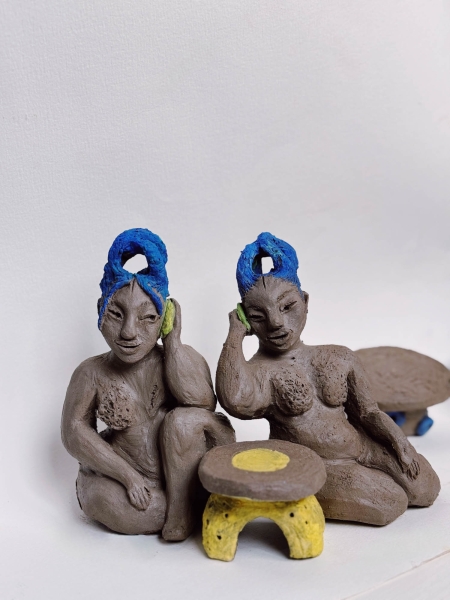
From ‘Apoti Conversations’.
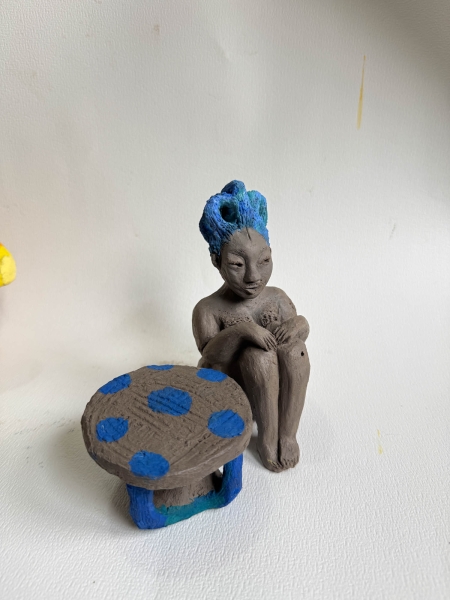
From ‘Apoti Conversations’.
ID: What are you currently working on, and should we anticipate a solo exhibition this year?
FK: I have a specific project I’m doing with AMAH Studio called ‘Apotti Conversation,’ which is about feminine friendships and relationships. It is a statement and my longest work here. I was inspired by the stories I would hear when I sometimes go to my friend’s house and we’re just sitting here talking and relaxing with an uplifting conversation. I realized that that was my dream and I wanted to create something like that. I’m also very close to my mum. When I was younger, we would just be relaxing, drinking tea and playing with my hair. So, I got the idea to make the project like a doll house. It’s very feminine. It starts off in a living room setting, and then when you see the activity inside, it’s just people chilling and eating all that time. It’s a cute, therapeutic project for myself. Because I do a lot of work with the family.
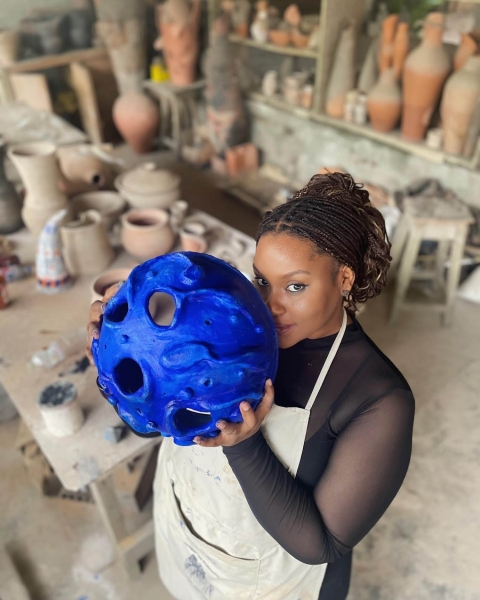
Fiyin in the studio holding a piece of her work.
